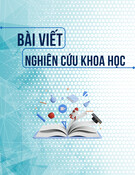
HUFLIT Journal of Science
ON THE FIGURE OF THE BOOK OF POETRY IN VIETNAMESE VOCABULARY
Nguyen Gia Khoa
Wuhan University, Hubei, P.R. China
khoang@hanu.edu.vn
ABSTRACT— Positioned within the East Asian cultural sphere, Vietnam has long been shaped by profound influences
from Chinese culture. The roots of Confucianism in Vietnam have extended for over two millenniums, with the formal
introduction of essential Confucian classics, including the Four Books and the Five Classics of China, occurring in the early
eleventh century following the country's attainment of independence. Among these Five Classics, the Book of Poetry holds
a significant place, garnering admiration from Vietnamese scholars of the past and endearing itself to the working
populace. The linguistic and cultural interconnections between Vietnam and China, coupled with the widespread
acceptance of the Book of Poetry's philosophy in Vietnam, have led to the gradual assimilation of numerous words and
allusions from this classic into the Vietnamese lexicon. Examining the semantics of select idioms and words, this paper
reveals that many of them convey aesthetically pleasing meanings, such as auspiciously blessing marriages, extolling the
love shared between men and women, praising the benevolence of parents, and commending the virtues of gentlemen,
women, and girls. This linguistic integration not only enriches the realms of Vietnamese literature, art, and language but
also assumes a pivotal role in shaping social moral education.
Keywords— the Book of Poetry, Confucianism, Vietnamese culture, Vietnamese vocabulary
I. INTRODUCTION
The Classic of Poetry, referred to as 詩經 (Shījīng, also romanized as Shih-ching, or She King) in Chinese, and
alternatively transliterated as the Book of Poetry, Book of Songs, Book of Odes, is the oldest extant anthology of
Chinese poetry and holds a position of utmost reverence as a classic in ancient Chinese literature. Other Confucian
classics, such as the Spring and Autumn Annals (春秋), the Book of Rites (禮記), the Analects of Confucius (論語),
the Mencius (孟子), frequently quoted from the Book of Poetry, attesting to its esteemed value. Confucius himself
spoke of the Book of Poetry’s profound value, stating, ‘The Odes serve to stimulate the mind. They may be used for
purposes of self-contemplation. They teach the art of sociability. They show how to regulate feelings of
resentment. From them you learn the more immediate duty of serving one’s father, and the remoter one of serving
one’s king. From them we become largely acquainted with the names of birds, beasts, and plants.’[4]. He also said,
‘In the Book of Poetry are three hundred pieces, but the design of them all may be embraced in one sentence —
‘Having no depraved thoughts.’’[4] Since the Han Dynasty, the second imperial dynasty of China (202 BC – 9 AD,
25–220 AD), Chinese literature has been deeply influenced by the Book of Poetry. Vietnam, a country within East
Asian cultural sphere, is no exception to this influence.
Many studies have pointed out that the Book of Poetry, as one of the Confucian classics, has been spread in Vietnam
at least for thousands of years. The An Nam chí lược (安南志略, literally Abbreviated Records of An Nam) records
that in 1007, "In July of the fourth year (of the Jingde reign of the Song Dynasty), the Acting Regional Military
Governor of Jinghai Circuit (also known as An Nam 安 南 ) Lê Long Đĩnh, dispatched his younger brother Lê Minh
Xưởng and the Chief Secretary Hoàng Thành Nhã to pay tribute to China. Long Đĩnh requested the Nine Classics
(Cửu kinh 九經) and a collection of Buddhist scriptures (Đại tạng kinh 大藏經, which was approved by the Song
Emperor." In the spring of 1009, Lê Minh Xưởng returned with Nine Classics and the Great Storage of Scriptures.
But in fact, during the one thousand years long history of "Vietnam under Chinese rule"
*
, the Four Books (Tứ thư
四書) and the Five Classics (Ngũ kinh 五經) have been introduced into Vietnam along with the Chinese rulers who
went to Vietnam to take office. Due to the active promotion of Xi Guang (錫光) in the Western Han Dynasty (202
BC – 9 AD), Ren Yan (任延) in the Eastern Han Dynasty (25–220 AD), Shi Xie 士燮 in the late Han Dynasty and the
early Three Kingdoms period (220 – 280 AD), the Grand Governor was actively promoted, Vietnamese
Confucianism has developed to a higher level which is "Xi Guang ruled Giao Chỉ (交趾 , modern Northern Vietnam),
Ren Yan ruled Cửu Chân (九真, modern Central Vietnam), they established schools, and taught etiquette and
righteousness." Ngô Sĩ Liên (?–?), a historian hailing from the Lê Dynasty (which governed Vietnam from 1428–
1527 and 1533–1789), reiterated the assertion that "Our Vietnamese people are adept in classics, notably the
Book of Poetry and the Book of Documents (尚書). They possess a profound understanding of rituals and music,
embodying the essence of a civilized nation since the era of King Shi (士王). The question arises: Do his merits and
*
Vietnam under Chinese rule (北屬時期: 111 BC–939, 1407–1428) refers to four historical periods when several portions of
modern-day Northern Vietnam was under the rule of various Chinese dynasties.
RESEARCH ARTICLE

50 ON THE FIGURE OF THE BOOK OF POETRY IN VIETNAMESE VOCABULARY
virtues extend beyond the contemporary era, resonating through the corridors of time to influence future
generations?"[5] In the 33th year of the Tự Đức reign of the Nguyễn Dynasty (1880), Nguyễn Văn San in his Sino-
Nom dictionary Đại Nam quốc ngữ (大南國語, literally National language of The Great Vietnam), the first sentence
of the Preface also indirectly confirmed that in the late Eastern Han Dynasty and the early Three Kingdoms period,
the Book of Poetry was translated by the warlord of Giao Châu (交州, modern Northern Vietnam and a part of
southern China) – Shi Xie and pointed out the shortcomings of the translation: "The languages of different
countries are different, and each country has their own language. Our nation has undertaken the translation of
Chinese phonetics from the era of King Shi. However, numerous aspects remain shrouded in mystery. For
example, include ‘Jūjiū 雎鳩’, the identity of which as a bird remains elusive, and ‘Yángtáo 羊桃’, the nature of
which as a type of wood remains unknown, and there are many similarities." Since then, the Book of Poetry and
other Chinese Confucian classics have established a profound presence in Vietnam's historical and cultural
landscape. Beyond mere literary influence, the Book of Poetry has left an indelible mark on various facets of
Vietnamese society, including literature, the imperial examination system, vocabulary, plaques and numerous
other domains.
Researchers, who specifically studied the Book of Poetry in Vietnam have carried out various studies from two
aspects of literature and culture. For instance, Trần Lê Sáng [9][10] have explored the Vietnamese people's
feelings from the Book of Poetry, and also talked about the Book of Poetry in Vietnamese orthodox culture and folk
culture. From the Chinese edict form, the imperial examination, the inscription to folk poetry, articles, prefaces
and postscripts, and ballads, there are traces of the Book of Poetry. Đỗ Thị Bích Tuyển [2] and Phạm Ngọc Hàm [8]
also discussed the impact of the Book of Poetry on Vietnamese classical literature, pointing out that Vietnamese
classical literature, especially the poetry creation, borrowed the allusions in the Book of Poetry, and stressed the
impact of the Book of Poetry on Vietnamese literature creation. The study of Nguyễn Tuấn Cường [7] has
extensively investigated the various mumble translations of the Book of Poetry in Vietnam, with a total of 7 works,
19 versions and 31 volumes. He also has classified and evaluated from the aspects of textology, mumble philology
and mumble literature. Finally, he proposed that the research direction of this type of literature should be carried
out in three aspects: classics, poetics and linguistics. Nguyen Gia Khoa et al. [6] found that, among the investigated
Vietnamese ancient inscribed plaques, the most classical cited from the Four Books and the Five Classics is the
Book of Poetry with 120 pieces of inscribed plaques, accounting for around 17.9 percent of the 680 inscribed
plaques examined.
Chen Jihua [1], a Chinese scholar, started from the perspective of Vietnamese toponymy research, used the general
annals of Vietnam’s Nguyen Dynasty geography general chronicle – Đồng Khánh địa dư chí (同慶地輿志, literally
the Descriptive geography of the Emperor Đồng Khánh) as the corpus, and found more than 130 names that
coincide with the words in the Book of Poetry from more than 8,500 village names in Northern Vietnam. He
highlighted that the apparent correlation between these intersecting names and the Book of Poetry was not a mere
coincidence. Furthermore, he conducted an analysis of the social and historical factors contributing to the
linguistic foundations of these overlapping names, considering elements such as the promotion of enlightenment,
the Imperial Examinations, and the pursuit of elegance.
II. THE BOOK OF POETRY IN VIETNAMESE PEOPLE'S DAILY LIFE LANGUAGE
Among the Vietnamese language lexicon, there are also certain words or idioms that are "self-created" based on
the Book of Poetry. While the quantity of these words is limited, they are used frequently, and Vietnamese have
used them skillfully in their daily life. The quintessential manifests in the imperative for individuals to encounter
or partake in a significant life event, namely, the institution of marriage. Within the spectrum of traditional
customs observed during Vietnamese weddings, a notable ritual unfolds on the official day of matrimony. The
groom's residence displays the “Lễ Thành Hôn” (Chénghūn Lǐ 成婚禮) plaque, signifying 'the Wedding Ceremony,'
while the bride's abode showcases the “Lễ Vu Quy” (Yúguī Lǐ 于歸禮), denoting 'the Going to [Future] Home
Ceremony.' The term " Yúguī 于歸" finds its origins in the third sentence of each chapter of the poem Taoyao 桃
夭 – Zhounan 周南 from the Book of Poetry:
The peach tree is young and elegant;
Brilliant are its flowers.
This young lady is going to her future home,
And will order well her chamber and house.
The peach tree is young and elegant;
Abundant will be its fruits.

Nguyen Gia Khoa 51
This young lady is going to her future home,
And will order well her house and chamber.
The peach tree is young and elegant;
Luxuriant are its leaves.
This young lady is going to her future home,
And will order well her family. [4]
The ancients held the belief that women were initially nurtured in the households of their biological parents, and
that the residence after marriage constituted their own familial domain. Therefore, getting married is called
"Yúguī/ Vu quy", which means going home. Nevertheless, in Vietnamese wedding ceremonies, a sign bearing the
words "Vu quy" is exhibited at the residence of the bride's family. This not only signifies that a woman from the
family is about to be married but also carries another meaning related to the last sentence of each chapter in a
poem: "Will order well her chamber and family." Beyond being a blessing for the bride, it serves as an expectation
for her future home. In addition, the word "gia thất" (jiāshì 家室, which means chamber and family) in the poem
is also a common word in Vietnamese, and the idiom "yên bề gia thất" (宜其家室) refers to the lives of men and
women who have entered into matrimony. The use of "Vu quy" and "gia thất" in lieu of the word "marriage"
represents a cultural expression that conveys blessings and serves as a reminder for the bride to establish a happy
family, thus embodying a distinct cultural essence. Additionally, various blessings from the Book of Poetry are
integrated into daily life, such as the phrase "Bách niên giai lão" (百年偕老, meaning "live together to be a hundred
years") to celebrate a married couple, and "Thọ tỷ Nam Sơn" (壽比南山, longevity akin to the South Mountain) to
felicitate the elderly, and so on.
The subsequent instance continues to focus on women. The word "tần tảo/ tảo tần" (蘋藻 pínzǎo/ 藻蘋 zǎopín)
originally means "蘋 pín" (which means the large duckweed) and "藻 zǎo" (which means the pondweed) – the two
names of aquatic plants. The ancients often used it as a sacrifice, so "pínzǎo" is also a synonym for sacrifice. This
word comes from the poem Caipin 采蘋 – Shaonan 召南 of the Book of Poetry:
She gathers the large duckweed,
By the banks of the stream in the southern valley.
She gathers the pondweed,
In those pools left by the floods.
She deposits what she gathers,
In her square baskets and round ones;
She boils it,
In her tripods and pans.
She sets forth her preparations,
Under the window in the ancestral chamber.
Who superintends the business?
It is [this] reverent young lady. [4]
In a question-and-answer format, the poem vividly and clearly describes the activities of women picking algae.
These items are used as offerings in ancestral rituals before marriage. The whole poem specifically points out the
sacrifice used for ancestor worship, the place of picking, the utensils used to contain and cook the sacrifice, the
place of ancestor worship and the person who presided over the sacrifice. This series of tedious activities
described the situation that women at that time had to prepare the sacrifice and sacrifice solemnly before
marriage, and praised the virtue of the girl at the same time. The preface of the poem Caipin of the Book of Poetry
states that: “The meaning of the poem Caipin is that if the wife of a senior official can follow the rules, she can
serve the ancestors of her husband and offer sacrifices to her husband's family.” Therefore, "pínzǎo" later also
refers to the norms of women's words and behavior. However, in Vietnamese, this word specifically refers to
women who work hard and diligently to take care of household chores and children, such as: "Mẹ tần tảo nuôi con
khôn lớn" (literal translation: The mother “pínzǎo” to raise her children to adulthood.), meaning "The mother
worked hard to raise her children to adulthood."

52 ON THE FIGURE OF THE BOOK OF POETRY IN VIETNAMESE VOCABULARY
Another illustration of the effort and acknowledgment parents investing in raising their children is encapsulated
in the idiom "chín chữ cù lao" (劬勞九字 , which means “nine words of toil”) refers to nine kinds of profound
virtues that parents generate and raise children. This idiom has repeatedly appeared in Vietnamese folk poetry
and literature. It comes from the poem Lu’e 蓼莪 – Xiaoya 小雅 of the Book of Poetry:
Alas! alas! my parents,
With what toil ye gave me birth!
[...]
O my father, who begat me!
O my mother, who nourished me!
Ye indulged me, ye fed me,
Ye held me up, ye supported me,
Ye looked after me, ye never left me,
Out and in ye bore me in your arms.
If I would return your kindness,
It is like great Heaven, illimitable... [4]
Among them, "toil" refers to the tiredness of parents when raising their children. And "nine words" respectively
is referred to nine verbs such as "begat", "nourish", "indulge", "feed", "hold up", "support", "look after", "never left"
and "bore". After the nine verbs, there are nine "me" words. The repeated words do not bring a complex and
monotonous feeling. Instead, it emphasizes that parents work hard for their children, which makes people deeply
sad and cannot help tears!
Moreover, many Chinese words or idioms from the Book of Poetry have been directly borrowed into Vietnamese
vocabulary. For instance, the word "phong nhã" (fēngyǎ 風雅 , which means elegant) originated from the Book of
Poetry. The Book of Poetry is also divided into three parts: Fēng 風, Yǎ 雅 and Sòng 頌. Among them, Fēng are the
folk songs of Zhou Dynasty, and Yǎ are the royal songs of Zhou Dynasty at the royal banquet or court meeting.
Later, "fēngyǎ" generally refers to people, especially a man's appearance, dignified behavior and elegance. In
Chinese, there are also terms that depict the aesthetic allure, demeanor, and comportment of women. For example,
"yểu điệu" (yáotiǎo 窈窕) is from the most famous book in the The Book of Poetry, which is also the beginning
poem of this classic - Guanju 關雎 – Zhounan 周南:
Kwan-kwan go the ospreys,
On the islet in the river.
The modest, retiring, virtuous, young lady:
For our prince a good mate she.
Here long, there short, is the duck weed,
To the left, to the right, borne about by the current.
The modest, retiring, virtuous, young lady:
Waking and sleeping, he sought her […][4]
The original meaning of "yáo" is profound, which is a metaphor for the beauty of women's soul; "tiǎo" refers to
the beauty of women's appearance. Similarly, "yểu điệu" in Vietnamese also refers to the beautiful appearance of
women's body shape. For another example, when Vietnamese describes the beauty of traditional Vietnamese
women, they often use the idiom "mắt phượng mày ngài" (鳳眼蛾眉, which means “Phoenix eyes, moth
eyebrows”). Accordingly, "mắt phượng" means the eye of the legendary bird Phoenix, which refers to the small
and upward eyes. And the word "mày ngài" (蛾眉) comes from the poem of Shuo Ren 碩人 – Wei Feng 衛風 of the
Book of Poetry: "Her forehead cicada-like, her eyebrows like [the antenne of] the silkworm moth; What dimples,
as she artfully smiled!"[4]. Hence, "mắt phượng" describes female’s eyebrows as long, thin and curved as silkworm
moth’s tentacles.

Nguyen Gia Khoa 53
Additionally, some words or idioms in the Book of Poetry have significant semantic changes when introducing into
Vietnamese. Such as, the idiom "Lang bạt kỳ hồ" (狼跋其胡 , which means “the wolf springs forward on his
dewlap”) comes from the first sentence of the poem Langba 狼跋 – Binfeng 豳風 of the Book of Poetry: "The wolf
springs forward on his dewlap; Or trips back on his tail"[4]. This refers to the situation of a wolf walking forward
is stepping on his dewlap, and then stepping on its tail when it retreats. In Vietnamese, "lang bạt kỳ hồ" has become
a common idiom, but its meaning has changed. "Lang bạt kỳ hồ" was interpreted as "living a wandering life in
other places" in the Vietnamese dictionary edited by Vietnam’s Institute of Linguistics (3). This idiom can also be
reduced to the two-syllable word "lang bạt" (狼跋) in Vietnamese, with its meaning unchanged and integrated
into a common word in Vietnamese vocabulary. For example: "Anh ta sống lang bạt, làm đủ nghề mưu sinh.”
(Literal translation: He living "langba" and making for a living.), meaning: "He is drifting all his life and making for
a living." It can be seen that although the meaning of the word is different, the efficacy of the lexical and syntactical
elements within the Book of Poetry in enriching the Vietnamese vocabulary warrants scholarly investigation.
III. CONCLUSION
It is a widespread phenomenon globally for languages to borrow words from one another. However, it is rare to
borrow words from a neighboring country's early poetry to enrich their own language vocabulary. Lê Quý Đôn
(1726-1784), one of the most outstanding and prolific Vietnamese polymaths, once discussed in his great
encyclopedia Vân đài loại ngữ (芸臺類語, literally Categorized Sayings from the Van Terrace), why the Book of
Poetry has had such a profound and extensive influence over thousands of years, and has become a classic admired
by literature throughout history: "The beginning of the poem is based on the heart of the people. More than three
hundred poems were mostly written by farmers and women, but some literati of later generations were unable
to reach them, which was based on their authenticity."
The enduring classic status of the Book of Poetry lies in its authenticity. Its extensive themes derive from everyday
life, depict historical events of the era, and resonate with the populace: expressing aspirations for a better life,
weariness of conflict, and admiration for the virtues of a royal concubine. Therefore, as soon as the Book of Poetry
was introduced into Vietnam, it was quickly preached and respected by all levels of social classes. Moreover, the
artistic techniques such as Fu, Bi and Xing found in the Book of Poetry, along with its poems characterized by
rhythmic musicality, bear striking resemblance to the songs and nursery rhymes cherished by the Vietnamese
people. These two characteristics make the Book of Poetry naturally enter the daily life of Vietnamese people, and
integrate into Vietnamese literature, art, language and many other aspects. In the process of language use, people
can use the allusions and sentences in the Book of Poetry when they need to. From the semantics of these idioms
and words, most of them express beautiful meanings, such as blessing a good marriage, praising the love between
men and women, praising the kindness of parents, and praising the virtue of gentlemen, women and girls. This
not only enriched Vietnamese literature, arts and vocabulary, but also played a significant role in social moral
education. Because of this, the literary critic Bùi Huy Bích (1744-1818), who was an outstanding student of Lê
Quý Đôn, once praised the Book of Poetry in his collection of Vietnamese poetry anthology Hoàng Việt thi tuyển
(皇越詩選 , literally Poetry Anthology of The Empire of Viet): "Alas! Poetry deserves to be called poetry, only three
hundred pieces (of the Book of Poetry) are worth it." I contend that such commendation is not unduly exaggerated.
IV. REFERENCE
[1] Chen Jihua (2017), The Relationship between Names of Villages in Northern Vietnam in the Nguyen
Dynasty and the ‘Book of Poetry’, Social Sciences in Heilongjiang, No. 5, pp.164-172.
[2] Do Thi Bich Tuyen (2005), A Preliminary Exploration of the Influence of the ‘Book of Poetry’ on
Vietnamese’s Sino-Nom Literature, 2005 Sino-Nom Studies Yearbook, pp.643–654.
[3] Institute of Linguistics of Vienam (2003), Vietnamese Dictionary, Da Nang Publisher, Da Nang, Vietnam,
pp.542.
[4] James Legge (1960), The Chinese Classics (Vol. IV): The She King, or The Book of Poetry, Hongkong University
Press, Hongkong.
[5] Ngo Sy Lien (2010), Complete Annals of Đại Việt, Social Sciences Publisher, Hanoi, Vietnam, 1250p.
[6] Nguyen Gia Khoa, Nguyen Ngoc Lan (2023), The Cultural and Literary Values on Ancient Vietnamese
Inscribed Plaque. Journal of Foreign Language Studies, Hanoi University, No. 73, pp.20–30.
[7] Nguyen Tuan Cuong (2006), Material on Nôm-translated ‘Book of Odes’– Initial Study on the Reserves,
Characteristics, and Values. Paper for The Second International Nôm Conference, Hue, Vietnam.
[8] Pham Ngoc Ham (2017), The Allusions from the ‘Book of Songs’ in Vietnam Classical Literature. Sinogram
Culture, No. 17, pp.28–32.
[9] Tran Le Sang (1995), A Brief Discussion on the ‘Book of Poetry’ in Vietnam. Guizhou Culture and History,
No. 04, pp.13–17.


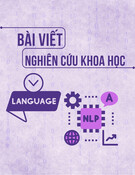
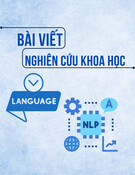
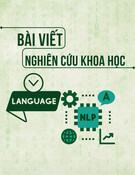
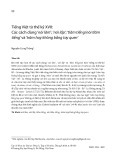


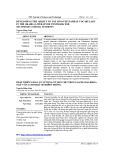

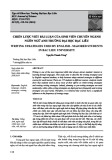
![Bộ câu hỏi trắc nghiệm Văn bản tiếng Việt [chuẩn nhất]](https://cdn.tailieu.vn/images/document/thumbnail/2025/20251127/thuynhung051106@gmail.com/135x160/24021764296609.jpg)
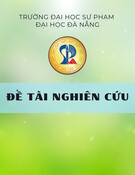

![Bài giảng Ngôn ngữ học đối chiếu Nguyễn Ngọc Chinh [PDF]](https://cdn.tailieu.vn/images/document/thumbnail/2025/20251101/vovu03/135x160/7471762139652.jpg)

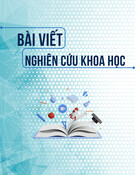
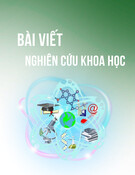

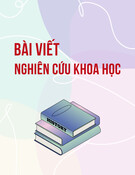
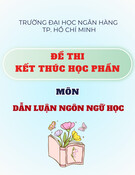

![Ngân hàng câu hỏi môn Tiếng Việt thực hành [chuẩn nhất]](https://cdn.tailieu.vn/images/document/thumbnail/2025/20251003/kimphuong1001/135x160/21861759464951.jpg)
![Bài giảng Văn học phương Tây và Mỹ Latinh [Tập hợp]](https://cdn.tailieu.vn/images/document/thumbnail/2025/20251003/kimphuong1001/135x160/31341759476045.jpg)

